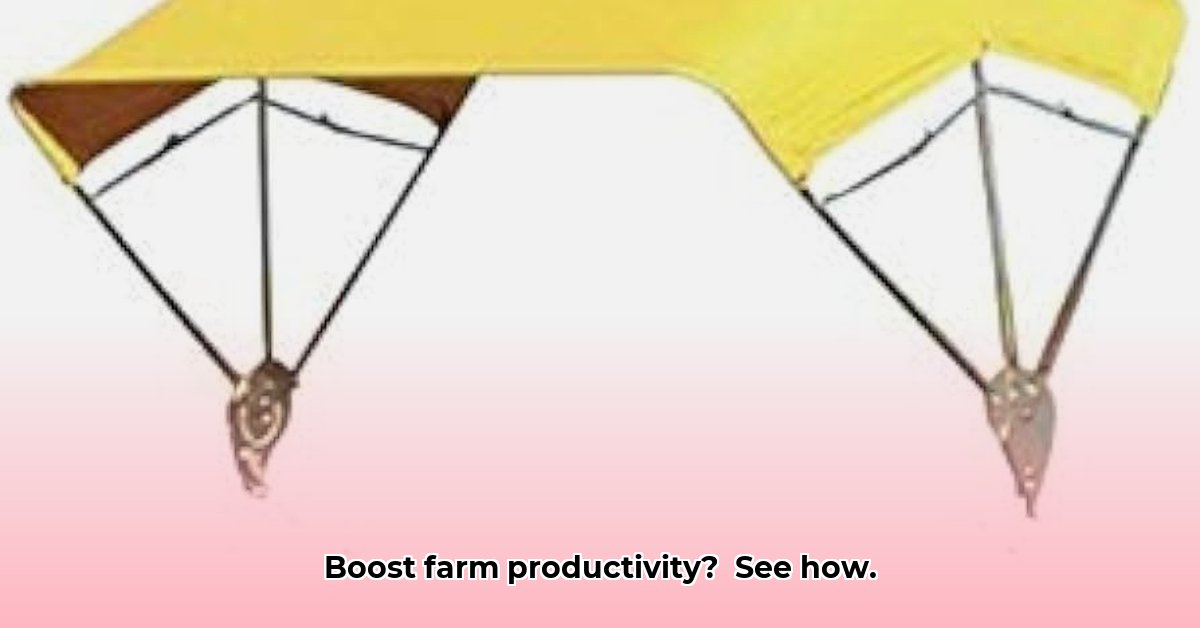
Canvas Tractor Canopies: Enhancing Farm Productivity and Operator Comfort
Working long hours under harsh weather conditions significantly impacts farmer well-being and farm output. High-density polyethylene (HDPE) tractor canopies offer a solution, providing protection from sun, rain, and wind, ultimately boosting productivity and comfort. This guide explores HDPE canopies, compares them to fabric alternatives, and provides a step-by-step installation guide. We'll also discuss long-term care to maximize canopy lifespan. Investing in a quality canopy is an investment in your farm's success. But how do you choose the right one? For more options, check out these tractor canopy options.
Choosing the Right Canopy Material: HDPE vs. Fabric
High-density polyethylene (HDPE) and fabric (canvas) represent the primary materials for tractor canopies. Each has specific strengths and weaknesses.
HDPE (High-Density Polyethylene): HDPE canopies are known for their exceptional durability and resistance to impacts. They're less prone to cracking or tearing than fabric canopies, resulting in a longer lifespan and reduced replacement costs. However, HDPE canopies are typically heavier and more expensive upfront. Dr. Amelia Hernandez, Agricultural Engineering Professor at the University of Illinois, notes, "While the initial investment in HDPE is higher, the longevity often outweighs the cost over several years of use."
Fabric Canopies: Fabric canopies, usually made from canvas or similar materials, offer a lighter, more affordable alternative. They are generally easier to install and handle and provide decent protection from sun and rain. However, they are less resistant to impacts and may sag or tear more readily over time, potentially leading to faster replacement cycles.
The choice between HDPE and fabric hinges on your priorities: longevity and durability versus affordability and ease of handling. Consider your budget, the typical weather conditions on your farm, and the intensity of your tractor's use.
Installation: A Step-by-Step Guide
Before installation, ensure your tractor has a Roll-Over Protection Structure (ROPS) (a safety cage protecting the operator in a rollover). Many HDPE canopies require a ROPS for secure mounting. Installing your canopy involves several steps:
Step 1: Preparation: Carefully read the manufacturer's instructions. Gather all necessary tools and thoroughly clean the ROPS to ensure a secure connection. This is crucial for both safety and canopy longevity.
Step 2: Attaching the Frame: Securely attach the canopy frame to the ROPS using the provided hardware. Tighten all bolts and connections completely according to the manufacturer’s specifications. Don't rush!
Step 3: Securing the Canopy Material: Attach the canopy material to the frame using straps, snaps, or other fastening mechanisms. Ensure the material is taut and free of wrinkles to prevent water pooling and potential tearing.
Step 4: Final Inspection: Conduct a thorough inspection of all bolts, straps, and connections. Make necessary adjustments for a snug, secure fit. A properly installed canopy is essential for both safety and maximum lifespan. If you’re uncomfortable with any step, seek professional installation.
HDPE vs. Fabric: A Detailed Comparison
This table provides a comprehensive comparison of HDPE and fabric canopies:
| Feature | HDPE | Fabric |
|---|---|---|
| Durability | High; resistant to impacts and tears; longer lifespan; lower replacement costs | Lower; susceptible to tears and sagging; shorter lifespan; higher replacement costs |
| Weather Protection | Excellent protection from sun, rain, and wind | Good protection, but potentially less effective in extreme weather conditions |
| Weight | Heavier | Lighter |
| Cost | Higher initial cost | Lower initial cost |
| Installation | Requires ROPS; may be more challenging | Generally easier; may or may not require ROPS |
| Breathability | Lower | Higher |
| Maintenance | Requires regular cleaning; potential need for UV protectant | Requires regular cleaning; more susceptible to damage from UV exposure |
Long-Term Care and Maintenance
Regardless of the material, UV degradation is a concern. Prolonged sun exposure weakens both HDPE and fabric. Regular cleaning, using a UV protectant coating (if recommended by the manufacturer), and proper storage can significantly extend a canopy's life. Regular inspections are crucial for early detection and repair of minor issues.
Conclusion: A Valuable Investment for Your Farm
Investing in a high-quality tractor canopy is a significant step toward enhancing operator comfort, productivity, and overall farm efficiency. By carefully considering the factors discussed – material choice, installation, maintenance, and sustainability – you can make an informed decision that positively impacts your farming operation for years to come. Remember, this is more than just shade; it's a long-term investment in your farm's success and your own well-being.